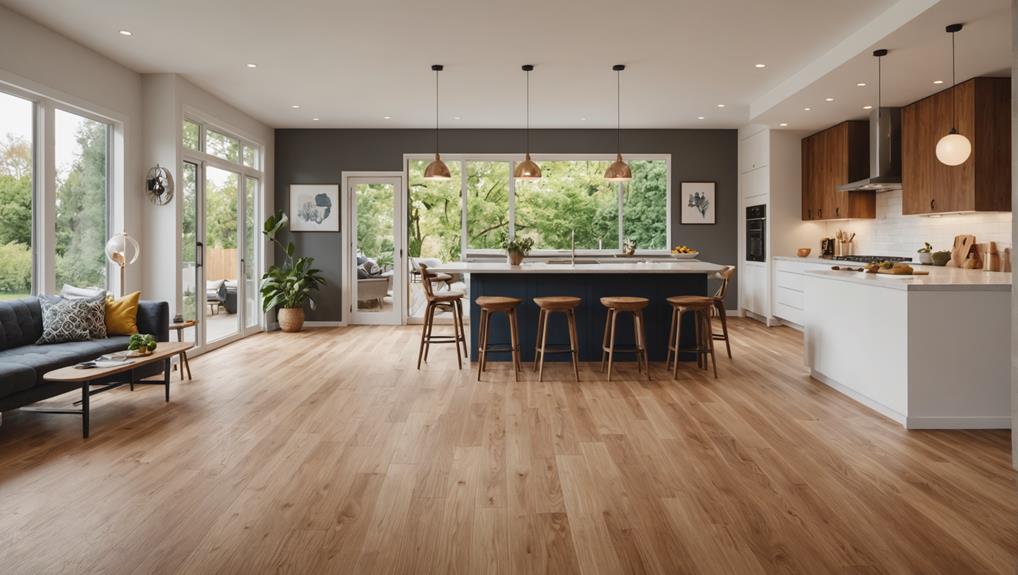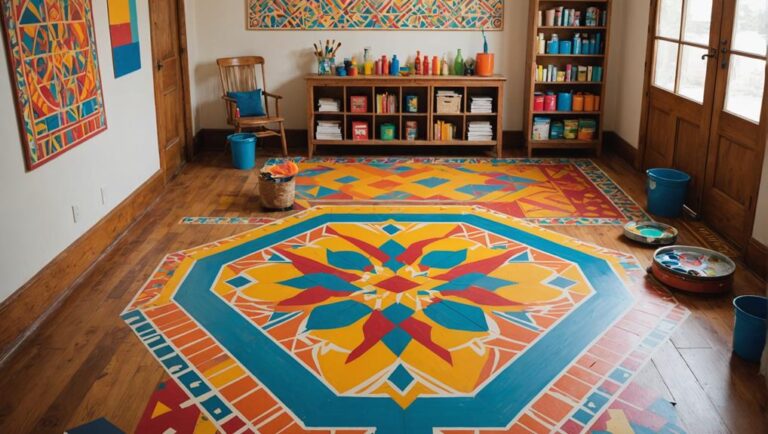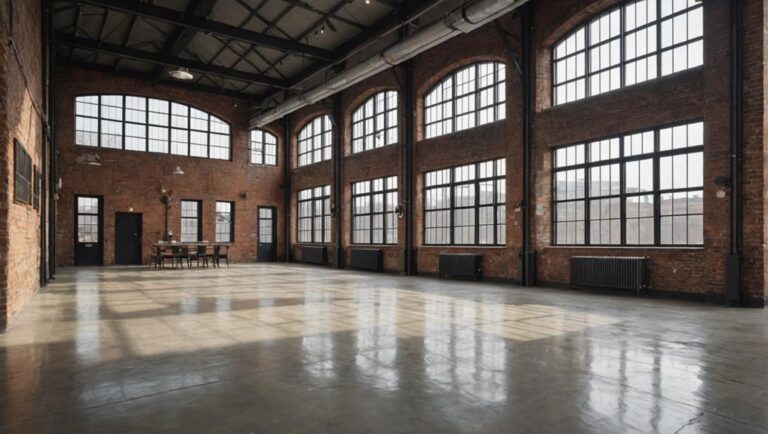When choosing flooring for your split-level home, consider safety and durability first. Opt for materials like luxury vinyl, laminate, or tile, especially in high-traffic areas. Choose slip-resistant textures, particularly if you have kids or pets. To create visual flow, pick complementary colors and textures across levels. Don't forget about proper alterations between floors; use gradual changes and effective lighting to enhance visibility. Finally, maintain your floors with regular cleanings to guarantee longevity. Discovering more specific details can help you make informed decisions tailored to your home's unique layout and style.
Understanding Split-Level Layouts
When you step into a split-level home, you'll immediately notice the unique layout that sets it apart from traditional designs. These homes typically feature staggered floors, which not only create a sense of openness but also offer various split level benefits. One major advantage is the efficient use of space; you can have distinct areas for living, dining, and sleeping without the need for extensive walls.
The architectural features of a split-level home often include multiple levels that are connected by short flights of stairs. This design can enhance sightlines and light flow, making the space feel larger and more inviting. However, it's important to take safety into account when maneuvering these levels, especially if you have young children or elderly family members in the home. Installing handrails and ensuring proper lighting on staircases can greatly reduce the risk of accidents.
Another benefit of split-level homes is their ability to blend with various landscapes and settings. Whether on a hillside or in a suburban neighborhood, these homes can adapt well, providing both aesthetic appeal and functional living spaces. Additionally, the separation of levels can offer privacy for family members, making it easier to coexist in a shared environment.
Choosing the Right Materials
The unique layout of split-level homes calls for careful consideration when selecting flooring materials. With multiple levels and varying traffic patterns, you'll want to choose options that guarantee safety and durability. One popular debate is wood vs laminate. While hardwood can add warmth and elegance, it may not withstand the heavy foot traffic and potential spills common in family areas. On the other hand, laminate offers a more resilient surface, mimicking the look of wood while being easier to maintain and more resistant to scratches and dents.
For areas prone to moisture, like bathrooms or kitchens, tile is an excellent choice. Tile durability is unmatched, providing a water-resistant surface that can handle spills and humidity without warping or damage. Additionally, consider slip-resistant tiles to enhance safety, especially if you have kids or elderly family members. Opting for textured tiles can provide extra grip, reducing the risk of slips and falls.
Another important factor is the insulation properties of your flooring. In split-level homes, choosing materials that help regulate temperature can improve comfort and energy efficiency. While wood and laminate can retain warmth, tile may feel cold underfoot in winter months. Using area rugs strategically can help counterbalance this effect, offering both comfort and safety.
Ultimately, when choosing flooring materials for your split-level home, weigh the pros and cons of each option carefully. Prioritizing safety and durability will guarantee your home remains a comfortable and welcoming space for everyone.
Color and Texture Considerations
Choosing the right color and texture for your flooring can greatly influence the overall aesthetic and atmosphere of your split-level home. When selecting flooring, contemplate how colors interact within the various levels. Using contrast colors can help define spaces, making each area feel distinct yet cohesive. For example, pairing a dark wood floor in your living area with lighter tiles in the kitchen can create a visually appealing separation while maintaining a harmonious flow.
Texture is another vital element. It's important to achieve texture harmony, especially in a split-level home where different areas may serve various functions. A smooth finish in high-traffic areas like hallways can enhance safety by reducing the risk of slips, while a textured finish in a family room can add warmth and comfort. Additionally, think about how textures can complement your furniture and decor. A soft carpet can provide a cozy feel in a bedroom or playroom, whereas sleek tiles can offer a modern look in a bathroom.
Don't forget to think about lighting, as it can greatly affect how colors and textures appear in your space. Natural light can enhance vibrant hues, while artificial lighting can soften them. Ultimately, choosing the right colors and textures not only elevates the design of your split-level home but also guarantees that each area feels inviting and safe. Always prioritize materials that are durable and easy to maintain, as this will contribute to a lasting and secure environment for you and your family.
Transitioning Between Levels
When shifting between levels in a split-level home, choosing the right materials is key to creating a seamless look. Consider using visual flow techniques to connect different spaces, which can enhance the overall aesthetic. Plus, addressing any height differences with thoughtful solutions will guarantee safety and comfort as you move throughout your home.
Material Selection Considerations
Changing between levels in a split-level home requires careful consideration of flooring materials to guarantee a seamless flow and aesthetic harmony. You'll want to explore eco-friendly options that not only look great but also align with your values. When choosing materials, consider budget-friendly choices that won't break the bank while still offering the durability ratings you need.
Think about indoor-outdoor compatibility, especially if you have an alteration to a patio or garden area. Noise reduction materials can enhance comfort, particularly in busy households. If pets are part of your family, pet-friendly flooring should be a priority, ensuring it withstands wear and tear while being easy to clean.
Moisture resistant selections are essential, especially in areas prone to spills or humidity. Pay attention to installation techniques, as a professional install can make a big difference in safety and longevity. Finally, consider maintenance requirements; select materials that are easy to care for to keep your home looking its best. By weighing these factors, you can create a beautiful and functional flooring solution that meets your needs while ensuring safety throughout your split-level home.
Visual Flow Techniques
Creating a cohesive look across different levels in a split-level home can enhance both the visual appeal and functionality of your space. To achieve visual continuity, begin by selecting flooring materials that complement each other. For instance, if you choose hardwood on the main level, consider a similar tone or finish for the stairs and lower levels. This creates a seamless shift that guides the eye throughout your home.
Design cohesion is also essential when considering patterns or textures. Opt for simpler designs on the stairs to maintain safety, especially if young children or elderly family members are present. Avoid busy patterns that can be visually distracting and may increase the risk of trips or falls.
Incorporate area rugs strategically to define spaces while maintaining flow. Confirm that the rugs are non-slip to enhance safety, especially on stairs or landings. Finally, consider color schemes that tie different levels together; using similar hues can create a unified look that feels intentional and inviting. By focusing on these visual flow techniques, you'll enhance both the aesthetic and safety of your split-level home.
Height Difference Solutions
Managing the height differences in a split-level home can be tricky, but with the right solutions, you can make changes between levels both safe and stylish. Addressing elevation shifts is essential for guaranteeing comfort and security throughout your space. Consider the following options to help you navigate these height adjustments effectively:
- Ramp solutions: Installing ramps can provide a smooth shift between levels, making it easier for everyone to move around.
- Stair enhancements: Upgrading your stairs with non-slip treads or wider steps can improve safety and accessibility.
- Threshold designs: Implementing stylish threshold designs can clearly mark where one level ends and another begins, serving as a visual cue.
When planning your flooring gradients, think about using level indicators to guide the flow and keep the design cohesive. For split shifts, guarantee that all changes are gradual, preventing any sudden drops that could lead to accidents. By incorporating these thoughtful strategies, you'll create a welcoming environment that prioritizes safety while maintaining aesthetic appeal in your split-level home.
Flooring Options for High Traffic Areas
When selecting flooring for high traffic areas in a split-level home, durability should be your top priority. You want something that can withstand the hustle and bustle of daily life while still looking great. Durable materials like luxury vinyl, laminate, or tile are excellent choices, offering both longevity and low flooring maintenance.
Consider slip resistance, especially if you have kids or pets. Textured surfaces can provide added safety, reducing the risk of slips and falls. Additionally, sound absorption is crucial in high traffic zones, particularly in split-level homes where noise can travel between levels. Look for flooring options that absorb sound, helping to maintain a peaceful environment.
Aesthetic appeal matters too; you can find eco-friendly options that fit your style. Many sustainable materials come in various designs, ensuring your flooring doesn't compromise on looks. However, be mindful of cost considerations; while some eco-friendly choices may be pricier upfront, their longevity can save you money in the long run.
Don't forget installation tips! Proper installation can enhance durability and performance. Finally, area rugs can serve as both a stylish accent and a protective layer. They can help manage wear and tear in particularly high traffic spots. If you have pets, consider pet-friendly choices that resist stains and scratches, ensuring your floors remain beautiful for years to come.
Enhancing Natural Light
If you want to brighten up your split-level home, consider using light-colored flooring to reflect more natural light. Additionally, optimizing window placement can considerably enhance the flow of sunlight throughout your space. These simple changes can make your home feel more open and inviting.
Use Light-Colored Flooring
Choosing light-colored flooring can considerably enhance the natural light in your split-level home, creating a more open and inviting atmosphere. Light-colored materials, whether hardwood, laminate, or tile, help reflect light effectively, making your space feel larger and more inviting. This visual spaciousness is especially beneficial in split-level designs, where rooms can sometimes feel cramped.
Here are some practical benefits of light-colored flooring:
- Improved Safety: Light flooring can make it easier to spot potential hazards, like spills or debris, ensuring a safer environment for your family.
- Versatile Style: Light colors complement various decor styles, allowing you to switch up your furnishings without worrying about clashing tones.
- Easier Maintenance: Light-colored flooring often hides dust and pet hair better, reducing the frequency of cleaning and maintenance.
Optimize Window Placement
Light-colored flooring not only brightens your space but also sets the stage for optimizing window placement. To enhance natural light in your split-level home, consider the orientation of your windows. South-facing windows typically receive the most sunlight throughout the day, making them ideal for light diffusion. You'll want to maximize these windows for a warm, inviting atmosphere.
Think about installing larger windows or even sliding glass doors on the south side to truly harness that light. If your windows are smaller, using mirrors can help reflect light deeper into your space. This is especially important in split-levels where certain areas can feel darker.
Additionally, consider the type of window coverings you use. Sheer curtains allow light to filter in while maintaining privacy, which is essential for safety. Avoid heavy drapes that block natural light; you want to create an open and airy feel in your home.
Lastly, think about landscaping—trees and shrubs can obstruct light if placed too close to windows. Trim them back or choose low-maintenance options to guarantee your home stays bright and welcoming. With these tips, you'll create a safer, more luminous environment in your split-level home.
Maintenance Tips for Longevity
Maintaining your flooring is essential for ensuring its longevity, especially in a split-level home where different levels can experience varying amounts of foot traffic and environmental exposure. By implementing effective cleaning routines and conducting seasonal inspections, you can keep your floors looking great and functioning safely.
Start by establishing a regular cleaning routine tailored to the type of flooring you have. For example, hardwood floors benefit from dry mopping followed by a damp clean with a product specifically designed for wood. Carpeted areas should be vacuumed frequently and professionally cleaned at least once a year. Here are some tips to help you maintain your flooring:
- Use mats: Place doormats at each entry point to help trap dirt and moisture before it reaches your floors.
- Regularly check for wear: During your seasonal inspections, look for signs of wear and tear, like scratches, dents, or stains, and address them promptly.
- Control humidity: In split-level homes, humidity levels can fluctuate. Use a dehumidifier to maintain a balanced environment, which helps prevent warping and mold.
Creative Flooring Patterns
When it comes to flooring in split-level homes, creative patterns can elevate the design and functionality of your spaces. Utilizing geometric designs and contrasting colors can make your home not only visually appealing but also safer by clearly defining different areas. This is especially useful in split-level homes, where various levels can create unique challenges regarding navigation and flow.
Here are some ideas to inspire your flooring choices:
| Pattern Type | Description |
|---|---|
| Herringbone | A classic pattern that adds depth and elegance. Ideal for living spaces. |
| Checkerboard | Provides a bold look using contrasting colors, perfect for entryways or kitchens. |
| Diagonal Lines | Offers a modern feel and can make narrow spaces appear wider. Great for hallways. |
| Circles & Arches | Softens sharp corners and adds a playful touch, suitable for kids' playrooms. |
Choosing the right patterns can help guide guests through your home while enhancing safety. For instance, a checkerboard pattern in a bright color can alert you to steps or changes in flooring levels. Always consider the functionality of each space; areas with more foot traffic may benefit from durable geometric designs that can withstand wear and tear.
Ultimately, don't shy away from mixing patterns! Just make sure they complement each other and maintain a cohesive look. With thoughtful design choices, you can create a safe, stylish, and inviting environment in your split-level home.
Frequently Asked Questions
How Can I Reduce Noise Between Split-Level Floors?
Picture yourself in a cozy café, sipping coffee, while the chatter of friends fills the air. Now, imagine that noise echoing between your split-level floors. To reduce this, consider effective soundproofing techniques like adding acoustic materials such as carpets or rugs, which absorb sound. Installing soundproofing panels on walls can also help. Don't forget about sealing gaps around doors and windows to guarantee a quieter, more peaceful home environment.
What Is the Best Underlayment for Split-Level Flooring?
When choosing the best underlayment for your flooring, you should consider options that provide moisture control and thermal insulation. A quality underlayment can help prevent moisture damage and enhance energy efficiency in your home. Look for materials like cork or foam, which not only absorb sound but also regulate temperature. This way, you'll create a comfortable, safe environment for you and your family while ensuring your flooring lasts longer.
Can I Install Flooring Myself in a Split-Level Home?
Yes, you can install flooring yourself in a split-level home, but be aware of some installation challenges. DIY flooring projects can save you money, but you'll need to take into account the layout and elevation changes. Make certain you have the right tools and materials, and always prioritize safety; wear protective gear and guarantee proper ventilation. If you encounter complicated areas, don't hesitate to seek advice or hire a professional to secure a flawless finish.
How Do I Measure for Flooring in Split-Level Spaces?
How do you guarantee you've got the right dimensions for your new flooring materials? Start by using measuring techniques like a tape measure to get accurate lengths and widths of each room. Remember to note any changes in level or stairs, as they can affect your measurements. It's essential to double-check your figures, especially in split-level spaces, to avoid costly mistakes and guarantee a safe, snug fit for your flooring.
Are There Eco-Friendly Flooring Options for Split-Level Homes?
Absolutely, there are plenty of eco-friendly flooring options for you to evaluate! Look for sustainable materials like bamboo or cork, which not only reduce environmental impact but also offer durability. Make certain to check for green certifications to verify your choice meets safety standards. These options not only enhance your home's aesthetics but also contribute to a healthier indoor environment, making them a smart choice for your living space.




